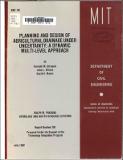Planning and Design of Agricultural Drainage under Uncertainty: A Dynamic Multi-level Approach
Author(s)
Strzepek, Kenneth M.; Wilson, John L.; Marks, David H.
Download10795598.pdf (10.12Mb)
Metadata
Show full item recordAbstract
Drainage systems are major capital investments for irrigated agriculture. Therefore,the-goal is to install drainage systems that will be most beneficial to the agricultural economy as a whole. Planning for agricultural drainage has been decomposed in this thesis as a three level process. The first level is the project evaluation and scheduling phase, the second level is the planning of the collector drain network, and the third level is the design of field level lateral drains. This thesis focuses on the second and third levels of drainage planning and the interactions between these levels. Level three drainage design is based upon the physics of groundwater flow. This thesis uses the steady state Hooghoudt equation for drain design currently employed in many areas of the world to determine the depth and spacing of subsurface lateral drains. This thesis analyzes the uncertainty in the parameters of the Hooghoudt equation. A detailed analysis of soil permeability shows that uncertainty and spatial variability are important issues in drain design and should be incorporated into the design process. First order-second moment analysis is a methodology that provides a measure of uncertainty in a system output (mean and variance) given uncertainty in system inputs. A first order second moment analysis is performed on the Hooghoudt equation than relates uncertainty in drain performance to parameter uncertainty and system design. Two models are developed to optimally design lateral drains given uncertainty in drain performance: Chance Constraint and Stochastic Programming. The thesis shows that the Chance Constraint approach is not valid when the system response function is not monotonically non-decreasing. In drainage design the system response function is many times not monotonically non-decreasing, however, the stochastic programming approach is valid for all types of response functions. A multicrop spatially distributed loss stochastic programming model for uniform lateral design over a collector area that accounts for uncertainty and spatial variability of soil permeability by Kriging, an optimal data interpolation technique that accounts for spatial structure, as well as accounting for economic response of multiple cropping of agricultural land. A simulation model for level two collector drain network planning is developed. This model provides the designer with a tool for drain sizing and cost estimation of complex network alignments allowing many alternatives to be evaluated and the least cost alternative system to be selected. An analysis is performed that-show that as a result of spatial variability the efficiency of the lateral field drain system. Present drainage planning is a sequential process that does not evaluate the impact of level two design upon level three. This thesis presents a dynamic multi-level planning process that incorporates feedback between level two and level three planning. A synthesis of the collector network simulation model and the multi-crop spatially distributed loss stochastic programming model with Kriged input for the lateral drainage system is performed to provide a methodology for dynamic multi-level planning. A case study of this proposed methodology on a drainage region in the Nile Delta in Egypt is carried out. The case study shows that this methodology can provide more efficient drainage systems while providing the most economical design.
Description
Scanning notes: Disclaimer inserted for illegible graphs and text. The authors would like to thank the MIT Technology Adaptation Program for their support of this research through a grant from Agency for International Development of the U.S. Department of State.
Date issued
1982-07Publisher
Cambridge, Mass. : Ralph M. Parsons Laboratory, Hydrology and Water Resource Systems, Massachusetts Institute of Technology, Dept. of Civil Engineering
Other identifiers
281
Series/Report no.
R (Massachusetts Institute of Technology. Department of Civil Engineering) ; 82-39.Report (Ralph M. Parsons Laboratory for Water Resources and Hydrodynamics) ; 281.TAP report ; 82-5